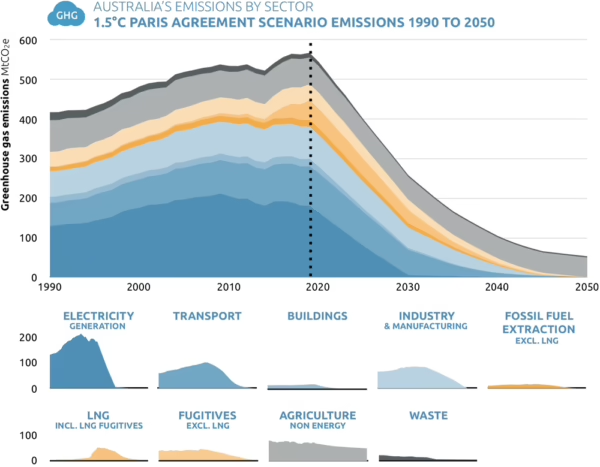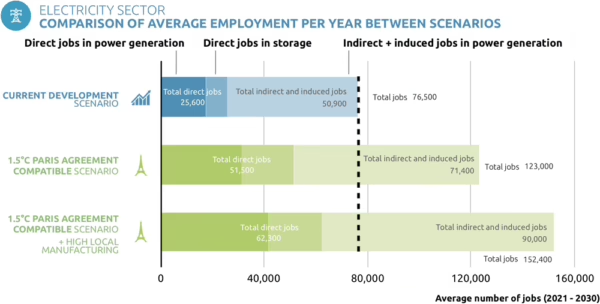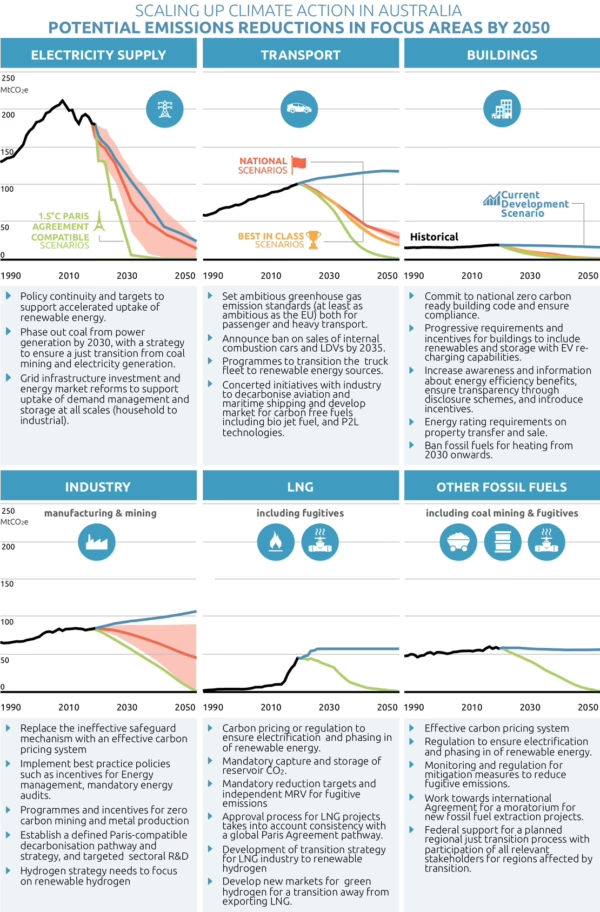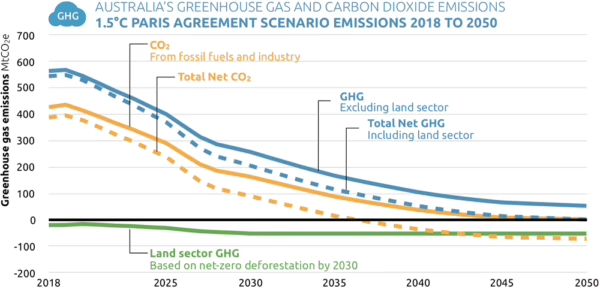Scaling up Climate Action in Australia
Authors
Ursula Fuentes, Bill Hare, Anna Chapman, Tina Aboumahboub, Himalaya Bir Shrestha, Anne Zimmer, Charlotte Plinke, Michiel Schaefer, Robert Brecha, Matt Gidden. Graphic design: Matt Beer

Australia can decarbonise its energy system by 2050 by scaling up climate action in its electricity supply and energy end use sectors, creating up to 76,000 additional jobs in the renewables sector alone.
The 1.5°C limit in the Paris Agreement is of critical importance for Australia. The continent is highly exposed to climate change impacts like sea level rise, coral reef loss, wildfires and extreme weather events. All of these effects can already be observed today and will be much worse in a 2°C world, compared to 1.5°C. Especially for tropical coral reefs, including the Great Barrier Reef, the difference between 1.5°C and 2°C is likely to be decisive if any reefs are to survive.
This report, the sixth country assessment in the Climate Action Tracker’s Scaling Up Climate Action Series, shows where Australia can accelerate its climate action. The report illustrates GHG emission reductions from these actions, along with employment and other benefits and the policies across all sectors that will bring emissions down fast enough.

Our analysis starts with an in-depth review of Australia’s current policy framework and sectoral developments and compares them with the comprehensive policy packages and the progress of the kind of sector indicators required under Paris Agreement-compatible pathways. It then focuses on a scenario analysis showing how to scale up climate action in Australia to levels consistent with the Paris Agreement.
This report shows that Australia, has tremendous potential to scale up climate action in all sectors. Increasing . action would initiate sectoral transitions towards a zero-emissions society with the additional benefits of reducing air pollution, and creating employment including through new manufacturing value chains and new export opportunities based on renewable energy.
Key findings:
- Australia’s 2030 Paris Agreement target and its domestic policies are not compatible with the Paris Agreement’s 1.5°C limit. Australia will need to accelerate its climate action across all sectors of the economy and ratchet up the 2030 climate target to put the country on a path towards net zero GHG emissions by 2050.
- Increased climate action in Australia will achieve a wide range of benefits and build on existing technologies and current market developments to achieve cost reductions, particularly for wind, solar and storage technologies by taking advantage of the country’s extraordinary renewable energy resources.

- Accelerated climate action in line with the Paris Agreement-compatible scenarios across all sectors allows Australia to achieve emission reductions of about 50% below 2005 emission levels by 2030, and 90% reductions by 2050, excluding the uncertain and volatile Land use, land-use change and forestry (LULUCF).
- To achieve net zero by 2050 Australia’s 2030 GHG reduction target (including LULUCF) needs to be about 66% below 2005 levels. This is very close to the high end of the 2030 target range recommended by the Climate Change Authority in 2014 of 47-65% below 2005 emission levels.
- Australia can achieve net zero GHG emissions by 2050 if it takes action to halt deforestation by 2030, and if it maintains the storage of carbon in forests projected for 2030 until 2050. This would be needed to outweigh remaining greenhouse gas emissions from hard-to-abate sectors, particularly agriculture. To achieve this the 2030 GHG reduction target (including LULUCF) would be about 66% below 2005 levels.

- Achieving net zero GHG emissions by 2050 will require a whole of economy approach, with mitigation in the non-energy sectors alongside decarbonising electricity and electrification of industry and transport, the roll-out of renewable hydrogen and a balanced approach in the land-sector that protects biodiversity, water resources and avoids relying on carbon storage in the land sector beyond sustainable limits.
- Accelerating the transition towards a zero carbon, renewables-based electricity supply by the 2030’s will bring large domestic employment opportunities to Australia with about 46,000 additional jobs between 2021-2030 compared to the current trajectory and, if combined with a policy to incentivise more local manufacturing of wind turbines, solar panels and batteries would reach 76,000.
- Australia can decarbonise its domestic energy system by 2050 by scaling up action in the electricity supply, and energy end use sectors (manufacturing industry, transport and building sectors) —which cover around 70% of the Australia’s current greenhouse gas emissions.
- Electrification of end-use sectors is central to decarbonising the Australian economy, including electric mobility and green hydrogen for industry and transport, with benefits for the electricity system.
- Australia needs to urgently prepare for the global transition away from fossil fuels as the world implements the Paris Agreement with many countries now aiming for zero emissions by 2050 and can develop alternatives to exporting fossil fuel energy.
- By building on its extraordinary renewable energy resource and high skills base, Australia can become a regional and international frontrunner in successfully transitioning its energy system to zero carbon. The result will be more sustainable employment, reduced levels of air pollution, water demand and new manufacturing value chains and export opportunities based on zero emissions energy carriers including renewable electricity offshore, green hydrogen and energy intensive products such as green steel.












